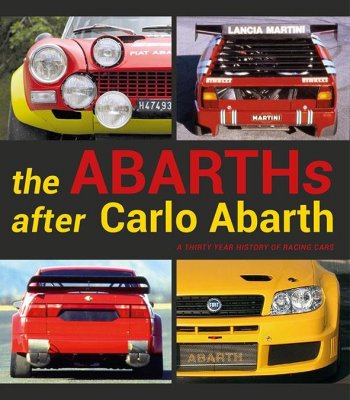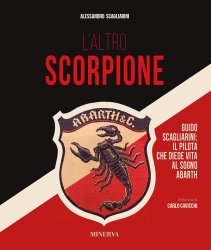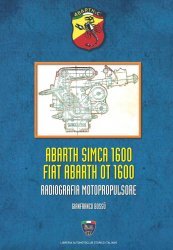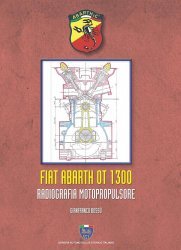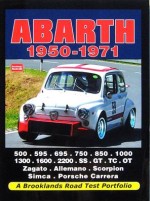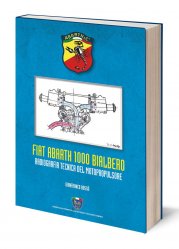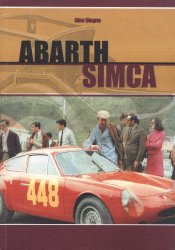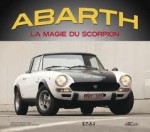This book is a collection of notes dedicated to all those who helped the engineer Sergio Limone to "play with cars" for so many years and allows Limone to believe that, ultimately, the effort was really worthwhile.
A “notebook” in lieu of a book, because books have a different narrative style, the authors intention with this document is to highlight, for the benefit of interested readers, the work of many people during the period from 1972 to 2005 (33 years of competition cars and other projects) and the achievements, led by a group of technicians whose roots went back to the Abarth of the 1960s, when the company was headed by Renzo Avidano and Mario Colucci.
Since then, the Abarth company has changed hands many times over, has been merged and transformed, but its technical strengths have always remained at the forefront, as a common thread.
Car models were produced and achieved greater or lesser success in an endless procession, and the projects were named according to a system rooted in the very origin of Abarth models: the code “SE” followed by a three-digit project number.
How the “SE” code came to be used is not that clear. When this code was used at Abarth, "SE" models alternated with those labelled “ES”, as can be seen from a list drawn up in 1975 that includes the models launched up to that time from 1960.
Some models, including highly prominent ones, whose name for various reasons did not include the “SE” code, are included in the list based on the chronology of their creation.
The Company setup changed several times, following various mergers involving Lancia, Fiat and Alfa Romeo.
The first “marriage” occurred in 1972, when the rally division of Fiat, headquartered in Corso Giulio Cesare, was merged into the recently acquired Abarth operation. In the late 1970s, Lancia Corse was also moved to the Corso Marche facilities, and in the late 1980s a single centre was created, with Abarth and Alfa Romeo technicians working on the competition models.
The Abarth logo was retained, albeit in the background, throughout the 1990s, when racing operations were managed by Fiat Auto Corse. On 1 July 2001, the company became NTechnology, an organisation external to, but controlled by, Fiat, and this remained in operation till the end of 2005.
At that point, the Abarth logo made its great comeback to centre stage.
Product specification
Additional information
Write a Review
Login or Register to write your review
You might also like
- Publisher: Asi
- Language: Italian
- Binding : In paperback
- Publisher: Asi
- Language: Italian
- Binding : In paperback
- Publisher: Brooklands Books
- Language: English
- Binding : In paperback
- Publisher: Asi
- Language: Italian
- Binding : In paperback
- Publisher: Fotograph Edizioni
- Language: Italian
- Binding : In paperback
- Publisher: E.t.a.i.
- Language: French
- Binding : In hardback
Per offrirti la miglior esperienza di navigazione possibile www.gilena.it utilizza i cookie. Vedi Informativa completa.
Preferenze sui cookie
Cookie essenziali
Utilizzati per le funzionalità vitali del sito, per garantire un esperienza utente ottimale
Cookie opzionali
Per funzionalità relative al marketing, alle statistiche e tutte quelle non ritenute essenziali
-
Shop by Category
Shop by Category
- Bus
-
Cars
Cars
- View all: Cars
- American cars
-
By marque
By marque
- View all: By marque
- Abarth
- Ac
- Alfa romeo
- Allard
- Alpine
- Alvis
- Alvis
- Amc
- Amilcar
- Amx
- Armstrong siddeley
- Asa
- Aston martin
- Ats
- Auburn-cord
- Audi
- Austin
- Austin healey
- Auto union
- Autobianchi
- Ballot
- Bentley
- Bianchi
- Bizzarrini
- Bmc
- Bmw
- Bolwell
- Bond
- Borgward
- Brabham
- Bristol
- Brm
- Bsa
- Bucciali
- Bugatti
- Buick
- Cadillac
- Chaparral
- Chenard & walker
- Chevelle
- Chevrolet
- Chevron
- Chrysler
- Citroen
- Cooper
- Cord
- Corvette
- Crossle
- Cunningham
- Daewoo
- Daf
- Daimler
- Dallara
- Datsun/nissan
- Db
- De dion-buton
- De lorean
- De soto
- De tomaso
- Delage
- Delahaye
- Diatto
- Dkw
- Dodge
- Duesenberg
- Edsel
- Elva
- Era
- Ermini
- F.a.t.a.
- Facel vega
- Farman
- Ferrari
- Fiat
- Ford
- Frazer nash
- Gaz
- Giannini
- Ginetta
- Glas
- Gm
- Gordini
- Gta
- Henney
- Hillman
- Hispano - suiza
- Hommell
- Honda
- Horch
- Hotchkiss
- Hudson
- Humber
- Impala
- Imperial
- Innocenti
- Isorivolta
- Isotta fraschini
- Itala
- Jaguar
- Jensen
- Jowett
- Koenigsegg
- Lagonda
- Lamborghini
- Lancia
- Lea-francis
- Lexus
- Life racing engines
- Limousine
- Lincoln
- Lola
- Lotus
- March
- Marcos
- Martini
- Maserati
- Matra
- Maybach
- Mazda
- Mclaren
- Mep
- Mercedes
- Mercury
- Messerschmitt
- Metro
- Mg
- Minerva
- Mini
- Mitsubishi
- Monica
- Morgan
- Morris
- Nash
- Nissan
- Nota
- Nsu
- Oldsmobile
- Om-iveco
- Opel
- Packard
- Pagani
- Panhard
- Panoz
- Panther
- Parnelli
- Pegaso
- Peugeot
- Pilain
- Pininfarina
- Plymouth
- Pontiac
- Porsche
- Puch
- Railton
- Range rover
- Reliant
- Renault
- Riley
- Rolls royce
- Rover
- Royale
- S.p.a.
- Saab
- Salmson
- Sauber
- Schweizer
- Seat
- Shelby
- Simca
- Singer
- Skoda
- Standard
- Steyr
- Studebaker
- Subaru
- Sunbeam
- Talbot
- Tatra
- Tecno
- Thunderbird
- Tiger
- Toyota
- Trabant
- Triumph
- Tvr
- Van diemen
- Vanwall
- Vauxhall
- Vedette
- Venturi
- Voisin
- Volkswagen
- Volvo
- Wanderer
- Wartburg
- Westfield
- Williams
- Willys
- Wolseley
- Car shows and museums
- Cars for kids
-
Coachbuilding, styling & design
Coachbuilding, styling & design
- View all: Coachbuilding, styling & design
- Alfa romeo
- Antem
- Asa
- Autodelta
- Bertone
- Bertoni flaminio
- Bmw
- Boneschi
- Brawand dany
- Campana
- Carcerano piero luigi
- Chappe & gessalin
- Chapron henri
- Charbonneaux philippe
- Cisitalia
- Colani luigi
- Colani lutz
- De tomaso
- Exner virgil
- Fioravanti leonardo
- Fissore
- Frua pietro
- Ghia
- Gilco
- Giugiaro
- Hebmuller
- Kellner
- Lancia
- Mantegazza
- Martin paolo
- Mathis emile
- Mays j
- Mercedes
- Michelotti giovanni
- Monteverdi
- Moretti
- Nissan
- Pininfarina
- Renault
- Reutter
- Riva
- Saab
- Saoutchik
- Sartorelli
- Sbarro franco
- Scaglietti
- Scioneri
- Siata
- Spada
- Stanguellini
- Touring
- Toyota
- Vignale
- Viotti
- Volkswagen
- Welter gerard
- Zagato
- Comics and drawings
- Yearbooks
- Collectibles
- Dvd & vhs
-
Manuals - technical books
Manuals - technical books
-
Military vehicles
Military vehicles
- Modelling
-
Motor sport and racing
Motor sport and racing
- View all: Motor sport and racing
-
Cars
Cars
- View all: Cars
- Aintree
- Autodromo di franciacorta
- Autodromo di pergusa
- Bahrain
- Birmingham
- Boavista
- Brands hatch
- Bridgehampton
- Brno
- Brooklands
- Buenos aires
- Can am
- Carrera panamericana
- Castle combe
- Charade
- Circuito del garda
- Circuito del jarama
- Circuito del mugello
- Circuito del valentino
- Circuito di cremona
- Circuito di lasarte
- Circuito di modena
- Circuito di napoli
- Circuito di pescara
- Circuito di piacenza
- Circuito di rouen les-essarts
- Coppa acerbo
- Coppa della perugina
- Coppa etna
- Coppa gordon bennett
- Coppa paolino teodori
- Corse in salita
- Dieppe
- Formula 1
- Formula 2
- Formula 3
- Formula 3000
- Formula 5000
- Formula ford
- Formula junior
- Francorchamp
- Giro di sicilia
- Goodwood
- Gran premi belgio
- Grand prix
- Hockenheim
- Imola
- Indianapolis
- Interlagos
- Kart
- Le mans
- Macau
- Martini racing
- Mille miglia
- Mintex
- Montjuic
- Montlhery
- Monza
- Nascar
- Nassau
- Nurburgring
- Oulton
- Paul-ricard
- Penya rhin
- Phillip island
- Rally
- Reims
- Sebring
- Silverstone
- Solitude
- Stock car
- Targa florio
- Tasman cup
- Thruxton
- Torrey pines
- Trans-am
- Vallelunga
- Vila real
- Westwood
- Zandvoort
- Zolder
- Motorcycles
- Paris-dakar
- Record
-
Motorcycles
Motorcycles
- View all: Motorcycles
-
By marque
By marque
- View all: By marque
- Aermacchi
- Ajs
- Ajs & matchless
- Ape
- Aprilia
- Ardie
- Ariel
- Benelli
- Beta
- Bimota
- Bmw
- Brough superior
- Bsa
- Bultaco
- Cagiva
- Ccm
- Cz
- Demm
- Derbi
- Dkw
- Douglas
- Ducati
- Egli
- Frera
- G.d
- Ganna
- Garelli
- Gilera
- Gitane
- Gori
- Guzzi
- Harley davidson
- Hercules
- Honda
- Horex
- Husqvarna
- Indian
- Jap
- Jawa
- Kawasaki
- Kreidler
- Ktm
- Lambretta
- Laverda
- Maico
- Maserati
- Matchless
- Mba
- Mm
- Mondial
- Monet goyon
- Montesa
- Morbidelli
- Morini
- Motobecane
- Mv agusta
- Mz
- Neftali ollearo
- Norton
- Nsu
- Opel
- Ossa
- Panther
- Parilla
- Peugeot
- Piaggio
- Puch
- Royal enfield
- Rudge
- Rumi
- Sanglas
- Sarolea
- Scott
- Sertum
- Sunbeam
- Suzuki
- Terrot
- Triumph
- Velocette
- Vespa
- Victory
- Vincent
- Wanderer
- Yamaha
- Zundapp
- Chopper
- Comics and drawings
- Sidecar
- Trike
- Yearbooks
- Off road
- Other subjects
-
Personality & driver
Personality & driver
- View all: Personality & driver
-
Car drivers
Car drivers
- View all: Car drivers
- Alboreto michele
- Alen markku
- Alesi jean
- Amon chris
- Andretti mario
- Ascari
- Bandini ilario
- Bandini lorenzo
- Barrichello rubens
- Bell derek
- Berger gerhard
- Biason miki
- Brabham jack
- Burns richard
- Caracciola rudolf
- Castellotti
- Clark jim
- Conrero
- Coulthard david
- Courage piers
- Darniche bernard
- De filippis maria teresa
- De Portago
- Dean james
- Fangio
- Fittipaldi emerson
- Frentzen heinz-harald
- Gurney dan
- Hakkinen mika
- Hawthorn mike
- Hill damon
- Hill graham
- Hunt james
- Ickx jacky
- Laffite jacques
- Lauda niki
- Loeb sebastien
- Mairesse willy
- Mansell nigel
- Marzotto
- Mckay david
- Mclaren bruce
- Mcqueen steve
- Mcrae colin
- Montoya juan pablo
- Moss stirling
- Musso luigi
- Nardi
- Nesti mauro
- Nuvolari tazio
- Peterson ronnie
- Pilette
- Piquet
- Pironi didier
- Prost alain
- Ragnotti jean
- Rainey joy
- Regazzoni clay
- Reutemann carlos alberto
- Rindt jochen
- Rohrl walter
- Rondeau jean
- Rosemeyer
- Rosier louis
- Russell jim
- Sainz carlos
- Sartarelli francesco
- Schumacher michael
- Scott brown archie
- Seaman richard
- Senna ayrton
- Serafini dorino
- Stewart jackie
- Stohl rudi
- Stohr siegfried
- Taruffi piero
- Toivonen henri
- Trips wolfgang von
- Vaccarella nino
- Varzi achille
- Villeneuve gilles
- Villeneuve jacques
- Villoresi luigi
- Von hanstein huschke
- Wimille jean-pierre
- Zanardi alex
- Magazines
-
Motorcycle drivers
Motorcycle drivers
- View all: Motorcycle drivers
- Agostini giacomo
- Anderson hugh
- Ballington kork
- Bandirola carlo
- Bayliss troy
- Benelli tonino
- Bergamonti angelo
- Biaggi max
- Bianchi edoardo
- Bianchi pier paolo
- Britten john
- Buscherini otello
- Capirossi loris
- Cau giuseppe
- Conti vittorio
- Dobb jamie
- Duke geoff
- Dunlop joey
- Dunlop robert
- Edwards colin
- Ermolenko sam
- Everett reg
- Finnegan martin
- Fogarty carl
- Gritti alessandro
- Hailwood mike
- Hannah bob
- Ivy bill
- Lazzarini enzo
- Lomas bill
- Lorenzo jorge
- Lucchinelli marco
- Mandracci guido
- Marquez marc
- Masetti umberto
- Mcgrath jerry
- Mcintyre bob
- Meier georg
- Miller sammy
- Muller egon
- Neumann-neander ernst
- Ostorero emilio
- Parlotti gilberto
- Pasolini renzo
- Penhall bruce
- Provini tarquinio
- Rainey wayne
- Read phil
- Rossi valentino
- Ruffo bruno
- Seeley colin
- Sheene barry
- Simoncelli marco
- Spencer freddie
- Stoner casey
- Surtees john
- Tenni omobono
- Testori imerio
- Vincent arnaud
- Wilkinson arthur george
- Personality
-
Tractors & caterpillar
Tractors & caterpillar
- View all: Tractors & caterpillar
- Caterpillar
-
Tractors by marque
Tractors by marque
- View all: Tractors by marque
- Allgaier
- Allis-chalmers
- Bubba
- Caterpillar
- Cletrac
- Cockshutt
- David brown
- Deutz
- Eicher
- Farmall
- Ferguson
- Fiat
- Ford
- Fordson
- Hanomag
- Hart-parr
- Holt
- International harvester
- J.i. case
- John deere
- Kramer
- Landini
- Lanz
- Marshall
- Massey
- Minneapolis-moline
- Nuffield
- O.m.
- Oliver
- Perkins
- Porsche
- Renault
- Same
- Steyr
- Tractractor
- Twin city
- Trucks
- [ Gift Cards ]
- New Releases
- Special Offers
-
Latest Additions
Latest Additions
- coming soon
- Events
- Account
-
Information
Information
Limited Stock Books
We generally have one or more copies of this book available: they may be in perfect condition or with some signs of wear, the price may vary depending on the state of conservation.
Please, contact us for information on the state of conservation and the selling price of this product.




